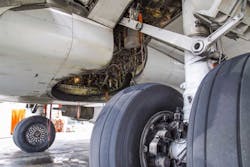Lessons Learned From Aircraft Maintenance for Patient Safety During Major Repair and Replacement
This article started when Bill Johnson (aka. Dr. Bill) was discussing his upcoming hip replacement (i.e., “major repair and alteration”) with Marc Szepan, a former Lufthansa senior executive and now a lecturer at the University of Oxford Saïd Business School. We talked about the surgery and realized that there might be similarities between performing “surgery” on Dr. Bill and an aging aircraft. Even more importantly, from Bill’s point of view, there surely could be similarities in terms of what one would expect from a hospital and a repair station. So, we discussed the characteristics of an aviation maintenance service provider and a hospital that would be most desirable to complete the service in an efficient, effective, and safe manner. Yes, even though the prospect of undergoing hip surgery isn’t all that pleasant, the discussion itself was fun. Here is a short summary …
Is A Repair Necessary?
First, there is the nonroutine finding and the necessity to undergo repair. Too many landing cycles or hard landings on an aging airframe can result in the main landing gear attach fitting not reaching its intended original equipment manufacturer (OEM) service life. Hopefully, any top-notch maintenance, repair, and overhaul (MRO) facility detects such damage, writes up a nonroutine finding and replaces the damaged or worn attach fitting. In the case of human beings, this sort of strain on the main landing gear system and its attach fittings – i.e., the legs and hips – can occur as well. Dr. Bill was fortunate that his doctor properly diagnosed failure of his right hip prior to reaching its, for lack of a better term and without any blasphemous intent, “OEM design life” and recommended to replace it as quickly as possible.
Right Service Provider
In general, many maintenance facilities offer landing gear services. It is very important to ask around to find the very best maintenance provider. It is important to find a MRO that is large enough to have top-notch hangars, shops, and modern equipment. On the other hand, the very busy large maintenance providers may be more focused on major airframe maintenance checks and structural repairs or full landing gear overhauls. That may mean that a mere main gear attach fitting replacement job may be squeezed in between the higher revenue big item jobs. Bill wanted a well-known provider that specialized in landing gear main attach fitting replacement and that took pride in performing this very procedure.
Of course, Bill wanted to be able to perform an informal on-site audit himself. That is not always possible. However, in our experience, nothing really beats walking around the flight line, the hangar floor, and engineering offices just to observe cleanliness, attitudes, and overall demeanor of people and to get a feel for the facility. The fact that the hospital and medical team welcomed patient safety questions, before the procedure, was a good sign they were on the right track. He found the right place.
Right People and Right Team
Maintenance work is based on highly qualified and experienced personnel, working together as a team, accomplishing the job with the highest care and resulting quality. Individual specialists must be properly trained and be current in their respective areas of work. For an individual, one-time customer, like Dr. Bill, it might not be feasible to check the credentials of all maintenance staff and to verify the level of recurrent training across the entire maintenance team. One must rely on the certification agency, like the FAA. We all know that there is variance across different Part 145 maintenance facilities but the certification agency(ies) must ensure an acceptable level of compliance to established standards. In the same spirit Bill selected medical professionals with the right type of initial training (i.e. medical school), evidence of adequate levels of recurrent training, and appropriate certifications.
Successful maintenance work is not just a function of the excellence of an individual contributor but a true team sport. Replacement of a landing gear main attach fitting can require Airframe and Powerplant (A&P) mechanics to remove and reinstall the landing gear, avionics mechanics to work on disconnecting and reconnecting wiring, structural experts to perform the replacement of the attach fitting itself, engineers to develop or coordinate repair schemes in case of secondary findings that are out of limit, tools and logistics specialist to ensure availability of spare parts, consumables, and tooling, facility experts to keep the hangar and shops in good condition, and – depending on an aircraft operator’s standards – pilots to perform a post-maintenance test or verification flight. Similarly, Bill did not judge the hospital of his choice by the quality/reputation of the orthopedic surgeon alone. Instead, Bill made sure to have a good feel for all other members of his surgical team – anesthesiologists, nurses, facility managers, etc. – in their own right and, above all, in terms of their team spirit.
Right Organizational Culture
Even the best people and the best team are likely to fail in a maintenance organization that has the wrong culture. A dedication to safety and to an appropriately configured safety culture must be a shared and non-negotiable goal throughout the entire organization. This safety culture must be lived, daily reality, and priority, and not just be relegated to second fiddle. Sometimes that is difficult to ascertain during a short on-site visit. But it certainly is worthwhile trying to verify this and to look for visible indications of a service provider’s safety culture.
For example, walk past bulletin boards and pay attention whether safety-related matters are displayed prominently, are kept up-to-date, and measure the right key performance indicators (KPIs). Ask about voluntary reporting systems. Ask how the organization deals with honest errors. Ask if individual employees get sufficient rest and if teams are adequately staffed for the tasks at hand. And given Bill’s background, you will not be surprised that Bill recommends inquiring about human factors training. Sometimes even the marketing material talks about safety. That’s worth looking for! Bill checked on all of this and only settled for a hospital once he was reasonably sure that the hospital had the same type of safety culture that he would expect from any repair station to which he would entrust an airliner repair.
Right Facilities, Equipment, Procedures, and Parts
The best people and best team working in the best organizational culture will struggle to produce high-quality repairs if they are forced to work without being properly resourced. If possible, check the facilities, the equipment, and the tooling that are made available to MRO employees. Good lighting, work stands for easy access, and cleanliness are important. Consider tooling and equipment-related procedures as well. Check specifics. For example, look into tool control procedures. Do mechanics perform a toolbox check upon completion of maintenance work? You don’t want tools left behind inside the airframe after closing up. And you certainly don't want your doctor to leave behind a scalpel or the like after closing the cowling. A old- fashioned television in the pre-operating prep room did raise concern, but the nurse commented that it was the oldest device in the hospital except for a couple of the nurses and doctors. She said that all surgical equipment was state-of-art and in calibration.
Regarding procedures, in general, are working procedures clearly documented, sound, and consistently applied? Do employees have easy access to and perform maintenance work in accordance with authorized and up-to-date controlled documentation such as aircraft maintenance manuals (AMMs) or structural repair manuals (SRMs)? Replacing the main attach fitting of a landing gear is a complicated procedure. First, the gear must be removed from the airframe (Figure 1). Then the main attach fitting must be replaced. In case of finding secondary corrosion, that must be removed. The gear must be mechanically reinstalled and all electrical and hydraulic lines must be reconnected. Hip replacement is similarly complicated (Figure 2). You want your surgeon to work in accordance with proper procedures. You surely don’t want your surgeon to – no pun intended – just “wing it”.
When undergoing parts replacement – i.e., a new hip – you want to make sure that the replacement part itself is of acceptable quality. Both in the case of “surgery” on human beings and on aircraft you want to beware of suspected unapproved parts (SUPs). Ask about the procedures your maintenance provider – i.e., hospital – has in place to control the risk of SUPs and most modern proven technology. Ask about procedures to ensure that consumables have not expired.
Dr. Bill looked into all of this before feeling at ease with his choice of hospital!
Aircraft Maintenance vs. Medicine
As an aviation safety professional, Bill appreciates the direct comparison between aircraft repair and surgery. Our maintenance processes, particularly our safety management systems, ensures continuing safety worldwide. Our industry strives to identify hazards thus seeking every opportunity to manage safety.
Especially a day before his surgery. Bill does not want to delve into medical patient safety statistics. They are not positively impressive. The good news is that medical professionals and hospitals are seeking advice from aviation safety risk experts. Some aviation safety consultancies have even reduced their aviation workload in favor of patient safety consulting, where the help is most certainly needed. Medical schools are increasing their offerings related to patient safety. Insurance companies have stepped up to pay for patient safety initiatives.
After having tried to do his homework of checking on people and teams, the organizational culture, and facilities, equipment, procedures, and parts at the hospital of his choice, Bill is ready for his major repair and alteration. He is looking forward to returning to walking and running his favorite trails. Better yet, to doing more “walk-arounds” at your MRO.
Postscript from Editor
Dr. Bill Johnson completed hip replacement surgery a day before this article went to the printer. The hospital performed like a top-notch MRO. Bill is doing fine. The Aircraft on Ground (AOG) time was extremely short with minor break-in required.
Marc Szepan is a lecturer at University of Oxford Saïd Business School. His primary professional experience has been in leading technical and digital aviation businesses in Europe, Asia, and the U.S. Most recently, he served as senior vice president, Airline Operations Solutions, at Lufthansa Systems, the IT services business segment of Lufthansa Group. He led a multi-business unit flight operations support business that served a global airline customer base. He also held leadership roles at Lufthansa Technik, the MRO business segment of Lufthansa Group, and for two other German industrial companies. In 2012, Marc was recognized as one of Aviation Week & Space Technology’s “40 Under Forty: Rising Stars of Aerospace and Aviation.”
"Dr. Bill” is a familiar regular columnist for AMT. For this article, he laughingly comments that “contents herein are his own and not necessarily representative of the Federal Aviation Administration.”
About the Author

Dr. Bill Johnson
Chief Scientific and Technical Advisor Human Factors in Aviation Maintenance, FAA
““Dr. Bill” Johnson is a familiar name and face to many industry and government aviation audiences. Johnson has been an aviator for over 50 years. He is a pilot, mechanic, scientist/engineer, college professor, and senior executive during his career. That includes 16+ years as the FAA Chief Scientific and Technical Advisor for Human Factors.
Dr. Bill has delivered more than 400 Human Factors speeches and classes in over 50 countries. He has 500 + publications, videos, and other media that serve as the basis for human factors training throughout the world.
Recent significant awards include: The FAA “Charles E. Taylor Master Mechanic” (2020); The Flight Safety Foundation - Airbus “Human Factors in Aviation Safety Award” (2018), and the International Federation of Airworthiness “Sir Francis Whittle Award” (2017).
Starting in 2021 Johnson formed Drbillj.com LLC. In this new venture he continues to bring decades of human factors experience to aviators, worldwide.
